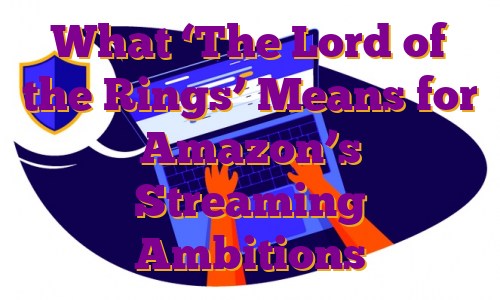The streaming service that an Amazon engineer once described as “a loss leader for Jeff [Bezos’] sex life” is making moves to improve its standing.
This week, Amazon Prime Video at last begins rolling out “The Lord of the Rings: The Rings of Power,” its long-awaited, monumentally expensive Tolkien adaptation. Expected (or at least fervently hoped) to become Amazon’s first true blockbuster series, “Rings” marks a culmination of the tech behemoth’s efforts in the streaming wars, its most earnest attempt yet to establish itself as a true rival to power players like Netflix, HBO Max and Disney+.
But if the series is indeed successful, we won’t have much by which to measure that success. Aside from the flawed metric of Nielsen streaming ratings — hardly the most important signifier of success in the streaming wars — Amazon has reported almost no significant numbers to quantify Prime Video’s performance.
More than 10 years into its existence, Prime Video’s identity and place in the streaming landscape is still not entirely clear, due largely to the fact that we have no firm idea of how many people are using it.
The most recent official membership figures for Amazon Prime were disclosed in April 2021, when Bezos said the program had more than 200 million subscribers worldwide, which of course does little to indicate how many people are using Prime Video. (The streaming service is also available as a standalone subscription.)
At the end of 2021, however, Amazon revealed that more than 200 million Prime members worldwide streamed shows and movies on the service during that year; more recently, in May, the company claimed 80 million U.S. subscribers have watched the service at least once in the past year. This would put Prime Video’s user base ahead of all major SVOD services’ domestic subscriber tallies.
Yet these numbers raise far more questions than they answer. How do they compare to years prior? How many of those subscribers are regular Prime Video users, and how many only used the service once or twice? How many subscribe to the standalone Prime Video option?
Prime Video is just one component of the value equation of a Prime subscription, albeit a valuable one; in a recent Morgan Stanley survey, 58 percent of respondents cited the streaming service as a reason they signed up for Prime, second only to two-day shipping for Amazon orders (73 percent). But Prime Video’s function, first and foremost, has historically been to reel in Prime subscribers who buy things from Amazon.
As such, for years Amazon treated Prime Video as little more than, well, a loss leader. The company was content to let the service produce critical darlings that drove buzz and won awards, rather than popular hits (a strategy now adopted by Apple, another tech giant dabbling in the streaming game that doesn’t disclose its subscriber totals). “When we win a Golden Globe, it helps us sell more shoes,” Bezos famously said in 2016.
But the mandate has shifted over time. Not long after the Golden Globe remark, Bezos was demanding his executive team produce Prime Video’s own “Game of Thrones,” which led Amazon to shell out $250 million just for the rights to make a “Lord of the Rings” series in 2017. Production costs for the show’s first batch of episodes ultimately totaled a reported $465 million, making it the most expensive season of TV ever produced.
The intervening years have also seen Amazon bring live sports to Prime Video with “Thursday Night Football” — in a 10-year deal worth over $100 billion — purchase the storied Hollywood studio MGM for $8.45 billion and balloon its content expenses (including both video and music) from $6.7 billion in 2018 to $13 billion in 2021.
Not for nothing, in July Prime Video also began rolling out a redesign of its user interface, a long-needed improvement the company inexplicably put off for years. In short, Amazon has finally been taking steps to turn Prime Video into a truly viable streaming wars combatant — and “The Lord of the Rings” is the keystone of that strategy.
But there has been little indication that Amazon is taking the next step needed to truly enter the streaming wars fray: regularly quantifying Prime Video’s user base.
Amazon may not see such disclosures as being in its best interest, but that would be a mistake. Keeping subscriber numbers hidden at this point only makes Prime Video look weaker, when competition among streamers is at its peak. If the numbers are good, why not come right out and say so?
Furthermore, for all its evident ambitions to compete with Netflix, HBO Max and the like, Amazon cannot truly claim success in a fight against its streaming rivals without directly measuring up against them. If the company wants to play in the same game as the other major SVODs, it needs to play by the same rules.
!function(f, b, e, v, n, t, s) {
if (f.fbq) return;
n = f.fbq = function() {
n.callMethod ?
n.callMethod.apply(n, arguments) : n.queue.push(arguments);
};
if (!f._fbq) f._fbq = n;
n.push = n;
n.loaded = !0;
n.version = ‘2.0’;
n.queue = [];
t = b.createElement(e);
t.async = !0;
t.src = v;
s = b.getElementsByTagName(e)[0];
s.parentNode.insertBefore(t, s);
}(window, document, ‘script’,
‘https://connect.facebook.net/en_US/fbevents.js’);
fbq(‘init’, ‘586935388485447’);
fbq(‘init’, ‘315552255725686’);
fbq(‘track’, ‘PageView’);


